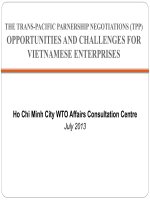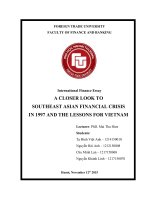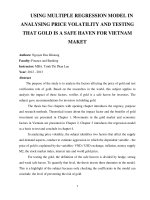What future gas price mechanism for vietnam
Bạn đang xem bản rút gọn của tài liệu. Xem và tải ngay bản đầy đủ của tài liệu tại đây (209.83 KB, 4 trang )
PETROVIETNAM
WHAT FUTURE GAS PRICE MECHANISM FOR VIETNAM?
Rebecca Keller
IHS
Email:
Summary
Gas market expansion proceeded in Vietnam through 2010 despite managed gas pricing, as most indigenous gas reserves could be
produced at a relatively low cost. But, as new sources of supply are higher cost, Vietnam must transition to a new pricing mechanism or risk
market stagnation and supply declines in the longer term. Vietnam is not alone in this situation, and can draw from lessons learned from
other markets in Asia to determine the appropriate pricing mechanism for the market context and government policy objectives. Successful
models include gradual introduction of market orientation and price increases.
Key words: Gas pricing, LNG.
Vietnam enjoyed strong gas market
expansion in the mid-2000s, through
integrated gas-to-power and fertiliser
projects which served as long-term offtakers
for offshore fields. From 2000 to 2010, annual
production grew by over 20% on average,
with sales priced at relatively low levels set by
the government. Prices were negotiated on a
bilateral basis for each project and approved
by the government and were initially in the
range of USD 1 - 4/MMBtu. From a policy
perspective, the government aims to keep
prices at a level that is affordable for the
price-sensitive power and fertiliser sectors,
which account for over 90% of demand. In
Vietnam, power generators face regulated
pricing for electricity sales which constrains
their ability to use higher-cost gas feedstock,
while they also faced fuel competition with
low-cost generation from coal and hydro
power.
This pricing mechanism worked for
market expansion initially because offshore
gas projects were relatively low-cost fields
to develop, especially for associated gas.
Vietnam was not alone in this approach;
many other developing countries in Asia
also put in place low, regulated pricing
to support initial development of their
domestic gas markets. But, unlike Vietnam,
many of these markets have moved towards
more market-oriented pricing mechanisms
to promote supply growth.
Vietnam gas market development
12
Stagnation
10
Market
Expansion
8
Bcm/a
1. Introduction
6
4
Early
development
2
0
1995
Power
1998
2001
2004
Fertilizer, Industry, and CNG
2007
2010
2013
Indigenous Production
© 2015 IHS
Source: IHS
2. Assessing Vietnam’s current gas pricing mechanism
Lack of indigenous gas resources or import potential is not to
blame for market stagnation. The BP Statistical Review of World Energy
reported the country has over 20Tcf (0.6Tcm) of gas reserves as of end2014 [1]. Vietnam has several large offshore gas discoveries which could
be developed to support greenfield power and petrochemicals projects.
In addition to domestic supply, Vietnam could benefit from tapping
into the global liquefied natural gas (LNG) market, which is entering a
period of supply abundance and a softening of prices caused by lower
oil prices and a number of new LNG export projects starting in Australia
and North America.
Lack of gas demand potential is also not hindering market growth.
Rising power demand from strong economic growth is creating
a huge need for new power capacity, while there is also scope for
gas to meet growing demand in the industrial and petrochemicals
sectors. The government has long recognised natural gas’ role as a
valuable fuel in the supply mix. Vietnam’s Gas Master Plan (GMP), last
released in 2011, targeted gas demand of 1.6 to 2.0Bcf/d by 2015
and 2.1 to 2.6Bcf/d from 2016 - 2026 [2]. Several new gas-fired power
plants were identified in Vietnam’s Power Development Plan (PDP)
PETROVIETNAM - JOURNAL VOL 10/2015
85
PETROLEUM ECONOMICS & MANAGEMENT
VII (2011 - 2030) to achieve a balanced power mix with
coal, the targeted primary generation source [3].
Rather, the gas market has been flat because of
delays in sanctioning proposed indigenous gas and LNG
import projects, whose successful development hinges
on an adoption of a new gas pricing framework. Other
supportive government policy is also required, but the
need to establish new pricing mechanisms is one of the
primary sources of project delay.
In Vietnam, regulated pricing at recent levels (USD 2
- 5/MMBtu) is seen as inadequate by upstream operators
to economically develop new gas projects. More difficultto-develop resources require a premium compared to
fields developed in the past. The proposed Block B gas
project offshore Southwest Vietnam is one such example.
Before Chevron divested its stakes to Petrovietnam in
mid-2015, it proposed peak gas flows of 490MMcf/d to
be delivered to onshore power plants. This would have
expanded the market by ~50% and been a key source of
power generation to meet rising electricity demand. But,
project sanctioning faced years of delay over negotiations
on gas price formation and the field development plan.
Chevron was reportedly seeking gas prices in the range
of USD 9 - 10/MMBtu, which would have been difficult
for baseload power plants to accept based on the current
regulated electricity pricing. Another large gas discovery,
ExxonMobil’s Ca Voi Xanh find, is also likely to be higher
cost than current production, due to the need to process
the field’s high carbon dioxide content. Additional
investment to develop associated gas pipeline and
downstream infrastructure in the relatively undeveloped
central region would lead to further price build-up for
offtakers.
in the GMP 2011, which proposed transitioning away
from the current managed policy towards a “competitive
wholesale market”. Without new investment, Vietnam’s gas
supply is at risk from production declines within 4 - 5 years,
which if unaddressed could lead to gas shortages and low
utilisation factors at gas-based fertiliser and power plants.
There is also the risk that Vietnam’s power generation mix
will become too heavily dependent on coal, with resulting
environmental and health consequences.
3. Gas price transition: Lesson learned from Asian markets
When determining an appropriate pricing
mechanism which works in the local market context,
Vietnam can draw from experiences of other countries,
which provide examples of different paths to price reform.
Based on economic theory, price formation should be
market-oriented, set by supply and demand conditions
and reflective of costs in the long run. But in practice,
gas pricing mechanisms are non-uniform globally, and
competitive traded gas hubs exist only in mature markets.
Common approaches for pricing are cost-plus schemes,
fixed price levels with built-in cost escalation over time,
or indexation to competing fuels such as oil or even coal.
Similarly, LNG imports into Vietnam will be higherpriced than current production, even under relatively
weak market conditions which started in late 2014. As
of mid-2015, both long-term contracted LNG and spot
cargoes are being delivered to Asian buyers at USD 7 - 9/
MMBtu, the lowest levels seen in years. Delivered costs to
end-users would reflect USD 1 - 3/MMBtu of additional
charges, making this gas stream much more expensive
than current supply.
For emerging markets, energy pricing evolves over
time, as markets develop and consumers’ ability to pay
increases. Regulated pricing is typical at first, to meet
objectives of energy affordability, and has been employed
across Southeast Asia, India, and China. But once
regulations are in place, it is difficult to enact reform, with
resistance from end-users accustomed to lower pricing.
The consequences of delaying reforms are high in the
long run: risking stranded gas resources, under-utilisation
gas-fired power plants, shortages in other sectors, and
a higher reliance on fuels which are more costly (oil
products) or have higher carbon emissions (coal). In
addition, if direct subsidies are in place, this creates a
high financial burden on the government and diverts
state investment from infrastructure and social spending.
Subsidies and regulated pricing create market distortions,
altering consumer behaviour and risking unsustainable
demand growth.
To realise market expansion and develop known gas
discoveries and proposed LNG imports, Vietnam will need
to transition to a new price mechanism which addresses
the higher cost of new supply. This issue has been
acknowledged by the government and was referenced
In Asia, price reform has typically occured when
countries face a need to develop more difficult and
costly indigenous resources or imports to grow supply.
In particular, many countries have found that introducing
LNG imports requires a new pricing mechanism to
86
PETROVIETNAM - JOURNAL VOL 10/2015
PETROVIETNAM
integrate costlier gas into the supply mix. Vietnam is experiencing
similar conditions, and will need to follow the path of other markets on
price reforms to realise similar supply growth.
In Southeast Asia, Indonesia is one of the leading examples of gas
reform success, while Vietnam can also draw lessons from the experiences
of China, India, and Thailand. In Indonesia and China, the move towards
market orientation has been gradual but steady. Indonesian energy
policy targets greater use of gas in a number of sectors, including power,
industry, and transport, to reduce the use of oil products and provide a
more balanced and sustainable energy mix. But to expand supply and
develop domestic gas resources, the government realised it needed
to raise pricing along the value chain. Upstream operators had long
voiced concerns that wellhead prices were not enabling cost recovery
for more difficult fields. Similarly, Indonesia priced domestic LNG at the
Asian benchmark, or the regional market price, for sales to local power,
industrial, and fertiliser consumers. While price hikes are resisted by
some end-users, overall the gas market has grown since reforms began.
China has introduced some reforms, but its gas market remains
heavily regulated so that the government can prioritise key sectors and
regions for gas supply and preferential pricing. Under this scheme, sales
prices have lagged supply costs, but this began to improve once reforms
were introduced in 2013. Since then, China has taken several moves
to introduce more market factors in price formation. For example, the
government has liberalised LNG imports, enacted direct negotiation for
industrial gas offtakers, and introduced some regional trading platforms,
such as the Shanghai Petroleum Exchange which began trading LNG
volumes in 2012.
Thailand provides an example of how another mechanism, gas price
pooling can integrate higher-cost gas in the supply mix. The country’s
Energy Industry Act of 2008 stipulated that tariffs should reflect costs
and provide a reasonable return on investment. As a result, prices follow
a market-based formula based on oil products pricing which is meant
to ensure consistent margins for suppliers. While the market historically
enjoyed low-cost gas from indigenous production in the Gulf of
Price
formation
in Asian
Asianmarkets
markets
in transition
Gas
price
formation:
in transition
12
USD/MMBtu
10
8
6
4
2
0
2005 2006 2007 2008 2009 2010 2011 2012 2013 2014
Indonesia (power sector)
China (average import price)
Source: IHS
India (wellhead, indicative)
Thailand (average cost of supply)
© 2015 IHS
Thailand, supply costs have gradually risen
for indigenous gas and oil-linked imports
from LNG and Myanmar pipeline gas.
Average wellhead prices have followed a
steady upward trajectory, from about USD
3/MMBtu in 2005 to USD 6 - 8/MMBtu since
2012. While LNG was imported for USD 15 16/MMBtu in 2013 - 2014 and pipeline gas
was in the USD 10 - 12/MMBtu range, the
impact on consumers was mitigated by the
weighted average cost of gas scheme. Endusers have still experienced price increases,
but in an incremental fashion which is
easier to accommodate.
India, by contrast, has delayed
adjustment of wellhead gas prices to reflect
higher development costs of new source
fields, and has seen stagnant/declining
production as a result. The market turned
quickly to LNG as a result, but importers
have faced issues finding consumers
who can afford higher-cost imports. To
accommodate price-sensitive but priority
sectors such as fertilisers and power plants,
the government has provided support in
the form of gas price pooling. It has also
subsidised higher gas feedstock costs, a
policy which is difficult to sustain in the long
run because of the drain on government
finances.
4. Conclusions
Examples of more successful reform
paths, such as those taken by Indonesia,
China, and Thailand, can provide lessons
learned for Vietnam as it determines a
new pricing mechanism to enable market
growth. As these markets became exposed
to international, market-based LNG pricing,
they enacted mechanisms to integrate
higher-cost LNG imports into the domestic
gas supply mix. This was done gradually
to avoid an abrupt impact on end-users
accustomed to lower pricing.
Ultimately Vietnam can not avoid a
move towards greater market orientation.
When establishing a new pricing policy,
PETROVIETNAM - JOURNAL VOL 10/2015
87
PETROLEUM ECONOMICS & MANAGEMENT
it is critical to adopt a scheme which enables adequate
return on investment to encourage future projects. This
would help attract private exploration and production
(E&P) companies to Vietnam which can expedite project
development for more costly or difficult projects through
investment and technology transfer.
stranded gas resources, and higher reliance on costlier or
higher-carbon fuels.
Energy affordability objectives, which have been
paramount in Vietnam, should be balanced with
those of energy security and sustainability. This does
not necessarily mean that affordability targets must
completely be sidelined. For example, many gas markets
in Asia continue to apply price discrimination by end-use
sector to address price sensitivity issues or encourage gas
usage. Rather, the government must consider its targets of
affordability against detrimental long-term consequences
of delayed price reform: market stagnation or decline,
2. Prime Minister. Decision approving the Master
Plan to develop Vietnam’s gas industry until 2015, with
orientations towards 2025. Decision No. 459/QD-TTg dated
30 March 2011.
88
PETROVIETNAM - JOURNAL VOL 10/2015
References
1. BP. BP statistical review of world energy. www.
bp.com.
3. Prime Minister. Decision approving the Master Plan
to develop national power system during the 2011 - 2020
period with vision towards 2030. Decision No. 1208/QD-TTg
dated 21 July 2011.









